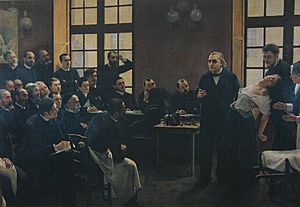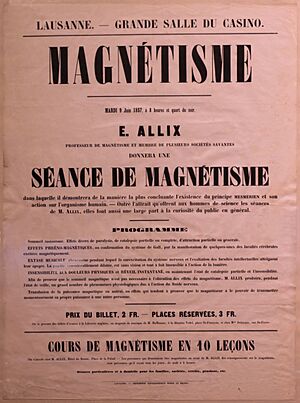Hypnosis facts for kids

Hypnosis is a special state of mind where a person is very open to suggestions. It's like being in a deep daydream or a trance. In this state, people are very relaxed and can use their imagination more easily.
Usually, one person, called the "hypnotist," guides another person, the "subject," into this trance-like state. While in this state, the subject can be influenced by what the hypnotist suggests. For example, the hypnotist might suggest that the room is hot, and the subject might start to feel warm.
Hypnotic suggestions can be given by a hypnotist, or a person can even do it themselves. This is called "self-hypnosis" or "autosuggestion." When hypnosis is used to help people with their health or feelings, it's called Hypnotherapy. When it's used for shows and entertainment, it's known as stage hypnosis.
Many people think hypnosis is like being asleep or unconscious, but that's not true. People under hypnosis are actually wide awake. They are just focusing their attention very strongly on one thing, which makes them less aware of other things around them. They also respond much more easily to suggestions. Because their behavior changes so much, it's often described as an "altered state of consciousness."
Contents
What is Hypnotherapy?
Hypnotherapy is when hypnosis is used to help people feel better. It can help with emotional problems or improve mental well-being. It's a type of therapy that uses hypnosis.
Sometimes, a person can use hypnosis on themselves. This is called "self-hypnosis." In self-hypnosis, a person acts as both the hypnotist and the subject. It's a way of using a trance state to help oneself.
A Brief History of Hypnosis
Early Ideas About Hypnosis
Many old societies had practices that were similar to hypnosis. Often, a special person like a shaman or priest would lead a ceremony. These ceremonies might use chants, music, or other things to help people enter an altered state of mind or a trance.
Even in ancient societies like ancient Greece, there were signs of hypnosis-like states. The Oracle of Delphi, for example, was said to be in a trance when she made her famous predictions. We don't know if this was self-hypnosis or something else.
Hypnosis in Western Societies
Modern ideas about hypnosis in Europe began with the work of Franz Mesmer. He didn't use the word "hypnosis" himself. Instead, he and his followers practiced something they called "animal magnetism," which later became known as mesmerism. From descriptions of his work, it seems clear that he had discovered what we now call hypnosis.
The words hypnosis and hypnotism come from the term neuro-hypnotism (meaning "nervous sleep"). This term was created by a Scottish surgeon named James Braid around 1841. Braid's ideas were based on Mesmer's work, but he had different theories about how it all worked.
Braid made important discoveries about hypnosis in 1842. He didn't believe that "mesmerism" was the reason for hypnosis. He thought that trances were just a kind of "nervous sleep." In 1843, he wrote a book called Neurypnology. In this book, Braid explained hypnotism as a state of deep physical relaxation that happens when someone focuses their mind very strongly.
How Hypnosis Works
Hypnosis can be used to help with many things, such as fears, emotional difficulties, pain management, and stress.
To do hypnosis, a hypnotist usually does two main things. First, they help the subject enter a trance state. Second, they guide the subject through the process, whether it's for therapy or another purpose. The hypnotist might switch between these steps, making sure the subject is in the right state of mind before continuing the process.
When a person is in a trance, they are very open to the hypnotist's suggestions. If the trance is deep enough, the subject will often accept what the hypnotist says as true. This is the main idea behind hypnosis: to get the subject into a trance so they will accept suggestions. However, subjects will not accept suggestions that go against their deepest beliefs.
Stage hypnotists can create amazing effects with good subjects. They might make subjects forget their names, believe they are someone else, or even see things that aren't there. This happens because the subject actively follows the hypnotist's suggestions. They do this because they trust the hypnotist and feel safe. If that trust is broken, or if the subject feels unsafe, they might come out of the trance.
It's important to remember that the power of hypnosis doesn't really come from the hypnotist. Instead, the power comes from the subject's own mind. The hypnotist simply knows how to guide the subject through the trance state.
Images for kids
-
Émile Coué helped develop autosuggestion.
See also
 In Spanish: Hipnosis para niños
In Spanish: Hipnosis para niños




